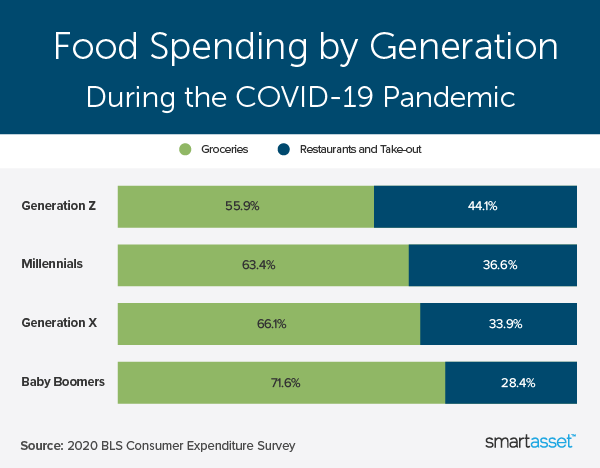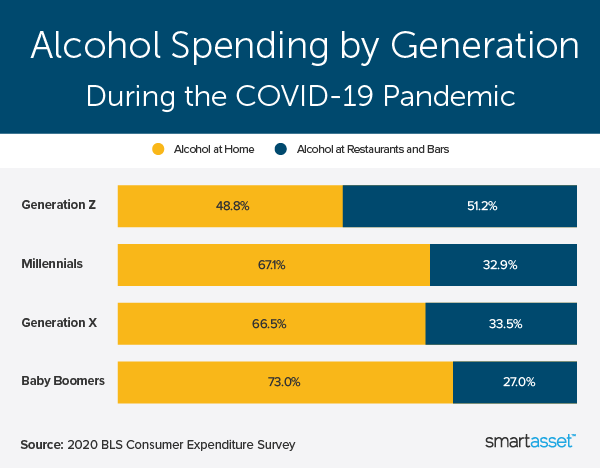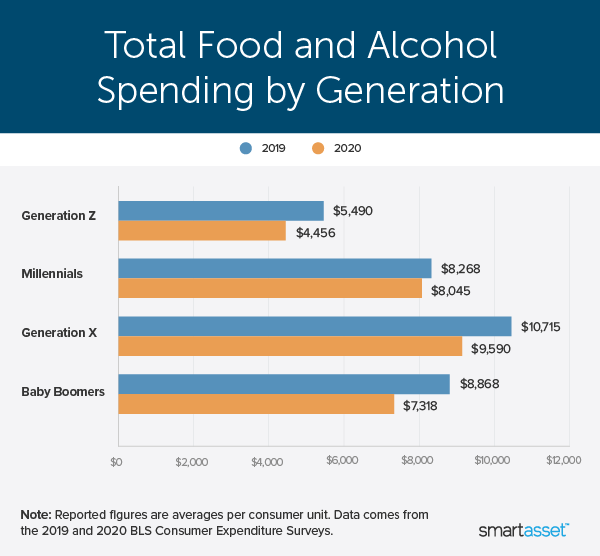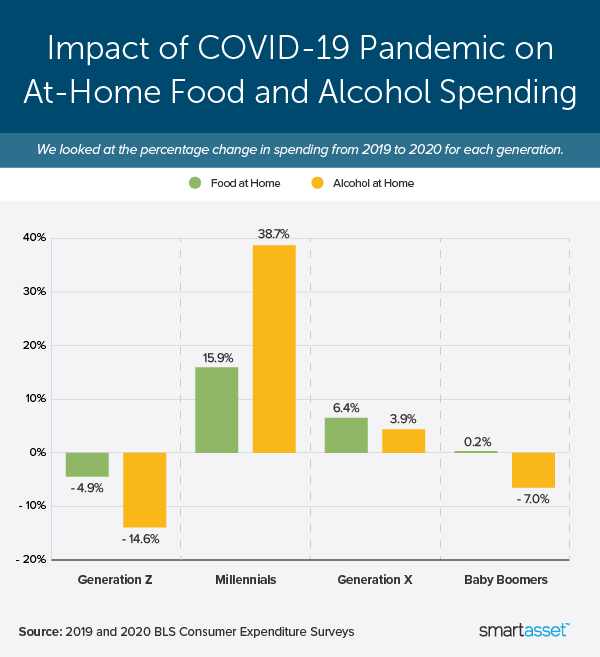Behind housing and transportation, food and alcohol is the third-largest spending category for the average American – totaling upwards of $7,000 per household in 2020, according to the Bureau of Labor Statistics (BLS). This figure differs wildly across generations, though. Average food and alcohol spending for Generation X tops $9,000 while the average Generation Z household spends the least, with about $4,500 outlaid annually on food and alcohol combined.
When the COVID-19 pandemic hit in 2020, American consumption patterns changed considerably, especially with regard to food and alcohol spending. In this study, we explored how the four largest living generations in the U.S. – Generation Z (born 1997 – 2012), millennials (born 1981-1996), Generation X (born 1965-1980) and baby boomers (born 1946-1964) – spend money on food and alcohol. Using data from the BLS’ 2020 Consumer Expenditure report, we discuss similarities and differences in spending for these two categories.
Key Findings
- Food and alcohol spending declined for all generations in 2020. The largest decrease came from Generation Z (-18.8%), followed by baby boomers (-17.5%), Generation X (-10.5%) and millennials (-2.7%).
- Spending on restaurants and take-out declined steeply from 2019 to 2020. There was a 32.6% average decrease in spending on food consumed outside of the home, in contrast to steady increases in previous years. There was a 24% decrease for this type of spending for millennials. Generation Z and Generation X spent about 31% less on food away from home, and baby boomer spending decreased by 41.6% on food away from home.
- Younger individuals are more likely to spend on food away from home, despite the pandemic. The youngest generation in this study (Generation Z) spent an average of 44.1% of their total food budget on restaurants and takeout, almost twice as much as baby boomers (28.4%).
- Generation Z spends most on alcohol at restaurants and bars while baby boomers spend the most on alcohol at home. An average of roughly 52% of alcohol spending for Generation Z went towards drinks at restaurants and bars. In comparison, baby boomers spent the least, with almost three-quarters (73%) of their total alcohol spending going towards drinks consumed at home.
Food and Alcohol Spending in 2020
Across all households, more than half of food spending goes towards food enjoyed at home. But one generation came close to an even split in their spending: Generation Z. This generation is more likely than other generations to spend money on food away from home, with 44.1% of total food spending going towards eating out and takeout.
In 2020, a clearer divide in food spending arose when the pandemic pushed food delivery services into the limelight as more people avoided going out to restaurants or making a trip to the local grocery store. Between the youngest generation (Generation Z) and the second-largest generation (baby boomers), there is a 15.7% difference between them when it comes to food spending away from home.
For groceries, spending increases as we look at the habits of successive older generations, with a 15.7% difference in amount spent on food at home between Generation Z and baby boomers in 2020.

In gross terms, the three larger generations in this study spend at least $500 on alcohol annually. Despite being less likely to spend as much on alcohol, Generation Z is the only generation that allocated more than half of its alcohol spending for drinks consumed at restaurants and bars (51.2%). By contrast, nearly three quarters of baby boomers’ alcohol spending is enjoyed at home. Millennials and Generation X both allocate two-thirds of alcohol spending on beverages at home.

How Food and Alcohol Spending Was Affected by the Pandemic
The pandemic caused a decrease in overall food spending from 2019 to 2020. Generation Z’s overall food spending decreased the most by 19%. Followed by baby boomers (-17.5%), Generation X (-10.5%) and millennials (-2.7%).
Like food spending, there was a decrease in overall alcohol spending from 2019 to 2020, with baby boomers spending 26.3% less compared to a decrease in alcohol spending of 13.9% by Generation Z. The only generation that was seemingly not affected were millennials, with a percent decrease of just 2.1%. The chart below shows changes in total food and alcohol spending by generation from 2019 to 2020.

Though overall food spending decreased for all four generations, three out of four generations increased their spending on groceries in 2020: millennials (15.9%), Generation X (6.4%) and baby boomers (0.2%). According to the USDA, 2020 was the first time since 2003 that food spending at home was higher than food spending away from home and it shows in the spending habits.
Millennials and Generation X also saw an increase in alcohol at home spending. Though total alcohol spending for millennials decreased by 2.1%, there was a significant change in allocation. In 2019, millennials allocated just $250 to alcohol at home on average compared to $347 in 2020. That’s a 38.7% increase. The only other generation to increase their alcohol at home spending was Generation X (3.9% increase).

Data and Methodology
Data for this report comes from the Bureau of Labor Statistics’ 2019 and 2020 Consumer Expenditures Surveys. All reported figures are averages per consumer unit. Consumer units include families, single persons living alone, single persons sharing a household with others while also remaining financially independent or two or more persons living together who share major expenses.
The BLS measures the variability of average expenditures by calculating a coefficient of variation, which is the standard error divided by the mean expenditure and is expressed as a percentage. Most estimated averages have a coefficient of variation less than 25 per BLS recommendations. The two estimates cited for which this is not the case are average alcohol spending at home and away from home for Generation Z consumer units.
Tips for Budgeting and Saving
- Make a plan, no matter your generation. Your spending may vary but that’s the nature of personal finance. It is, after all, personal. Take a look at our free budget calculator to map out your monthly and yearly expenses. Also take a look at our cost of living calculator to see how your city compares to others. The cost of living in a city can significantly affect your finances and ability to save.
- Being matched with the right financial advisor can make a world of difference in achieving your financial goals. SmartAsset’s free tool matches you with up to three financial advisors who serve your area, and you can interview your advisor matches at no cost to decide which one is right for you. If you’re ready to find an advisor who can help you achieve your financial goals, get started now.
Questions about our study? Contact press@smartasset.com.
Photo credit: ©iStock/Prostock-Studio
